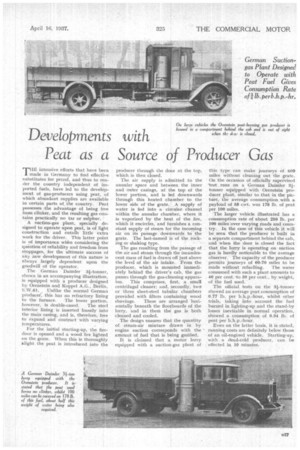Developments with Peat as a Source of Producer Gas
Page 41

If you've noticed an error in this article please click here to report it so we can fix it.
THE intensive efforts that have been made in Germany to find effective substitutes for petrol, and thus to render the country independent of imported fuels, have led to the development of gas-producers using peat, of which abundant supplies are available in certain parts of the country. Peat possesses the advantage of being free from clinker, and the resulting gas contains practically no tar or sulphur.
A suction-gas plant, specially designed to operate upon peat, is of light construction and entails little extra work• for the driver. This latter point is of importance when considering the question of reliability and freedom from stoppages, for the ultimate success of any new development of this nature is always largely dependent upon the goodwill of the operator.
The German Daimler ai-tonner, shown in an accompanying illustration, is equipped with a producer designed by Orenstein and Koppel A.G., Berlin, S.W.61. Unlike the normal German producer, this has no refractory lining to the furnace. The lower portion, however, is double-cased. The steel interior lining is inserted loosely into the main casing, and is, therefore, free to expand and contract with varying temperatures.
For the initial starting-up, the firedoor is opened and a wood fire lighted on the grate. When this is thoroughly alight the peat is introduced into the producer through the door at the top, which is then closed.
The air supply is admitted .to the annular space and between the inner and outer casings, at the top of the lower portion, and is led downwards through this heated chamber to the lower side of the grate. A supply of• water is fed into a circular channel within the annular chamber, where it is vaporized by the heat of the fire, which it encircles, and furnishes a constant supply of steam for the incoming air on its passage downwards to the grate. The last-named is of the rocking or shaking type.
The gas resulting from the passage of the air and steam through the incandescent mass of fuel is drawn off just above the level of the air intake. From the producer, which is mounted immediately behind the driver's cab, the gas passes through the gas-cleaning apparatus. This comprises, first, a small centrifugal cleaner; and, secondly, two or three sheet-steel tubular chambers provided with filters containing wood
shavings. These are arranged horizontally beneath the floorboards of the lorry, and in them the gas is both cleaned and cooled.
The design ensures that the quantity of steam-air mixture drawn in by engine suction corresponds with the amount of fuel that is being gasified.
It is claimed that a motor lorry equipped with a suction-gas plant of
this type can make journeys of 600 miles without cleaning out the grate. On the occasion of officially supervised 'test runs on a German Daimler 3-4tonner equipped With Orenstein producer plant, similar to that in the•picture,the average consumption with a payload of 58 cwt. was 178 lb. of peat per 100 miles.
The larger vehicle illustrated has a consumption rate of about 250 lb. per 100 miles over varying roads and country. In the case of this vehicle it will be seen that the producer is built in a separate compartment behind the cab, and when the door is closed the fact that the lorry is operating on suction gas is hardly noticeable to the average observer. The capacity of the producer permits journeys of 60-70 miles to be made without refuelling. The water consumed with such a plant amounts to 40 per cent. to 50 per cent., by weight, of the fuel used.
The official tests on the 3i-tonner showed an average peat consumption of 0.77 lb. per b.h.p.-hour, whilst other trials, taking into account the fuel burned in lighting-up and the stand-by losses inevitable in normal operation. showed a consumption of 0.94 lb. of peat per b.h.p.-hour.
Even on the latter basis, it is stated, running costs are definitely below those of an oil-engined vehicle. Starting-up, with a dead-cold producer, can be effected in 10 minutes.




























































































